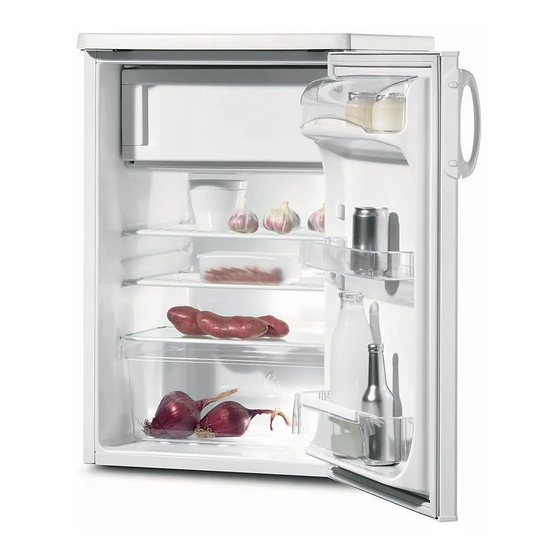Zanussi ZT 154 AO Gebrauchsanweisung - Seite 8
Blättern Sie online oder laden Sie pdf Gebrauchsanweisung für Kühlschrank Zanussi ZT 154 AO herunter. Zanussi ZT 154 AO 16 Seiten.

GB
At this type of appliance defrosting fresh food
compartment is automatic without any external
intervention.
The thermostatic control interrupts the operation of
compressor at regular intervals for more or less time -
during this cooling is interrupted - temperature of the
fresh food compartment increases and defrosting
occurs. After defrosting the thermostatic control restarts
operation of the system.
Melting water flows through defrost water outlet into the
evaporative tray maintained on the top of compressor and
evaporates due to warmth of it.
Check and clean the outlet of melting water
coming during defrosting regularly. If it is
clogged the melting water gathered can cause
earlier failure as it can go to the insulating of the
appliance.
Clean the melting water outlet with the supplied pipe
scraper that can be seen in the figure. The pipe scraper
has to be stored in the outlet.
Occasionally check defrost water outlet not to be
clogged up.
The most typical case of clogging up in the defrost water
outlet when you put food wrapped in some paper into the
appliance and this paper contacts back plate of fresh
food compartment and freezes to it. If you remove the
food right at this moment the paper will tear and it can
cause clogging up in the outlet by getting into it. So you
are asked to be careful - because of the above - when
placing foods wrapped in paper into the appliance.
In case of increased demand e.g. during
heatwaves, the refrigerator temporarily happens to
operate constantly. During this the automatic defrosting is
ineffective.
Remaining small ice and frost stains on back plate of the
fresh food compartment after defrosting period is not
abnormal.
The frozen food compartment can not be equipped with
automatic defrosting set since the deep-frozen and
frozen foods do not endure melting temperature.
So the enclosed plastic scraper is for scraping off and
removing frost and ice coating which possibly occurs in
44
the frozen food compartment and on the sealing of the
door.
The tray in figure is not a piece of accessories to the
appliance!
When ice coating is so thick that it can not be removed
with the plastic scraper, the frozen food compartment
has to be defrosted (generally 2-3 times a year).
Take the foods out of the frozen and fresh food
compartment, wrap them into some layers of paper or
cloth. Put them to a possible cool place while defrosting.
Break the circuit of the appliance and leave the doors of
frozen and fresh food compartment open.
Continuously blot off the defrosting water by a soft cloth
or sponge.
After defrosting wipe the surfaces, apply voltage to the
appliance and put the foods back to their places.
It is recommended to operate the appliance at the
highest position of the thermostatic control so that it can
reach the proper storing temperature as soon as
possible.
Regular cleaning
It is recommended to wash the inside of the refrigerator
in 3-4 weeks time.
Household cleaner or soap must not be used.
After you made it no-current wash the appliance using
lukewarm water and wipe it.
Clean the magnet door rubber profile with clean water.
After cleaning plug the appliance to the mains socket.
It is practical to clean and defrost the frozen food
compartment at a time and when it is empty.
Dust and dirt collected on the back of the refrigerator,
condenser is recommended to be removed and clean
the evaporative tray on top of the compressor once or
twice a year.
When the refrigerator is not in use
In case the appliance will not be used for a long time
follow these steps:
Break the circuit of the appliance.
Remove foods from the refrigerator.
Defrost and clean it as written before.
Leave the door open to avoid a build up of air inside.
